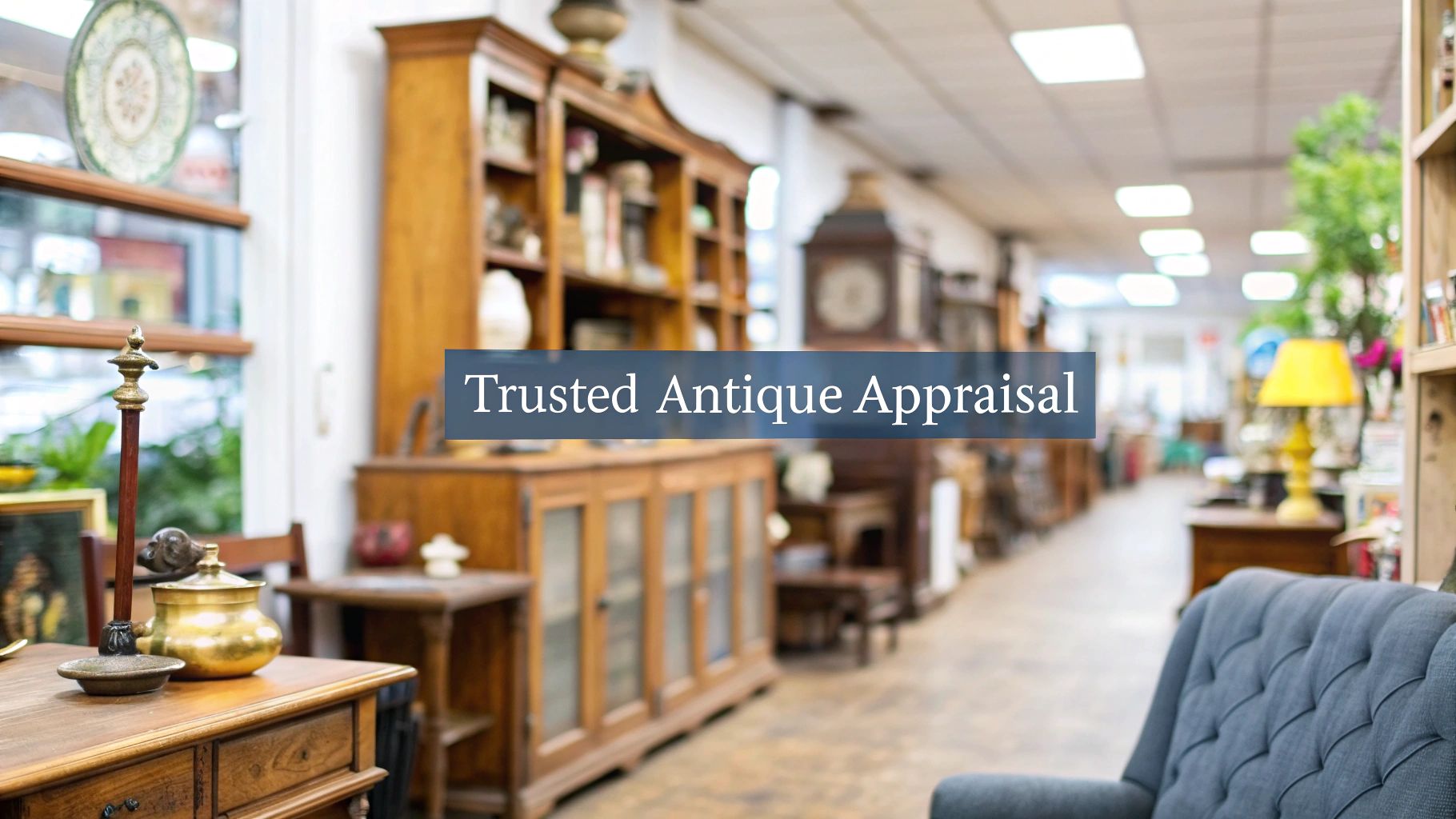Trying to figure out what your old treasures are worth? The first step is knowing what a real professional appraisal involves. It’s so much more than just a quick price guess; it’s about uncovering the story, skill, and market value behind your item.
Why a Local Antique Appraisal Matters
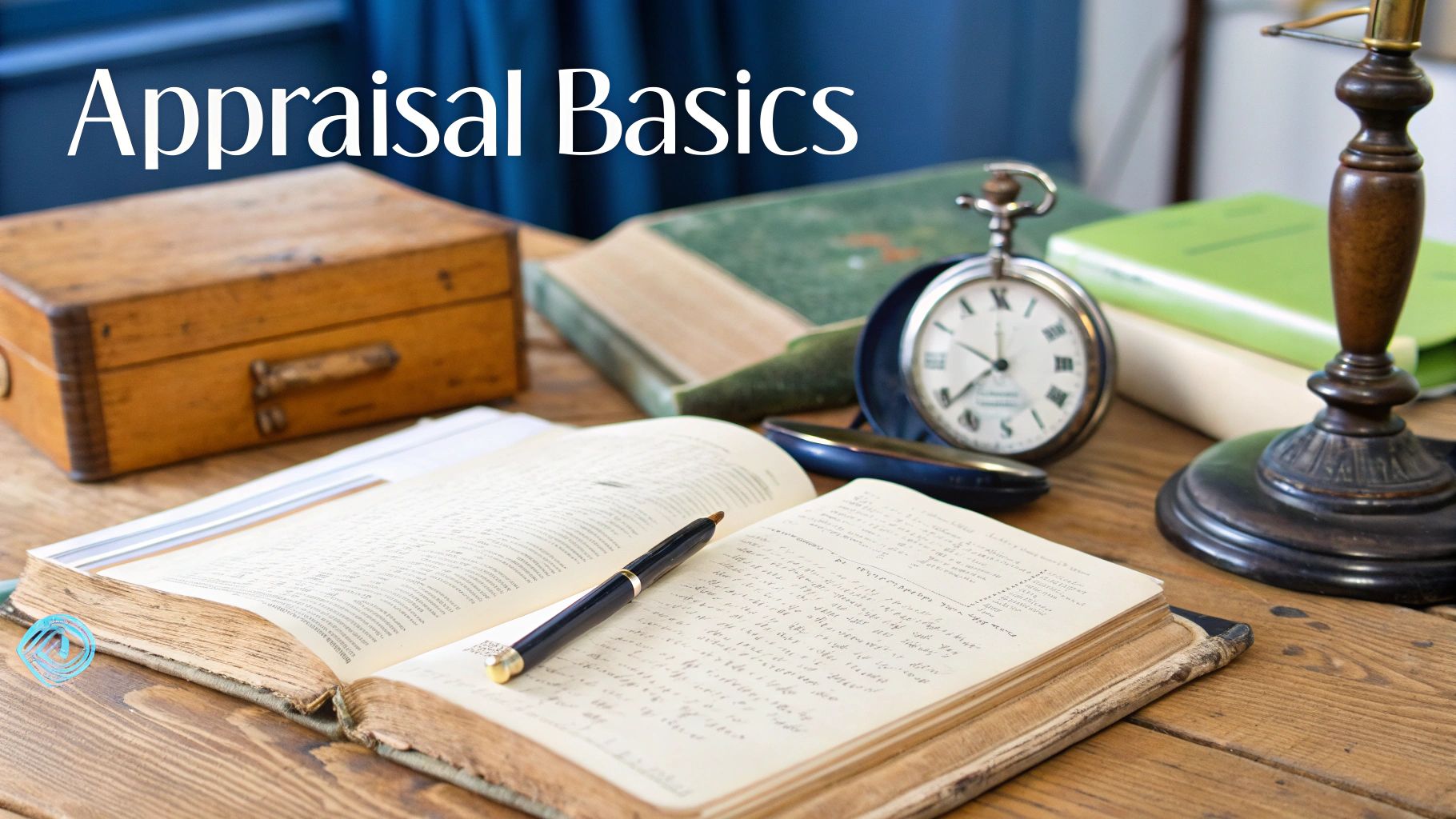
Before you even start looking for an appraiser, it's important to understand the difference between a casual estimate and a formal, written appraisal. An off-the-cuff opinion from an antique shop owner is great if you're just curious, but a certified appraisal is a legally defensible document you'll need for any serious financial matters.
Think of it this way: a formal appraisal is the official paperwork you'll need for:
- Insurance Coverage: Making sure your valuables are properly protected against theft, loss, or damage.
- Estate Planning: Ensuring a fair and equitable division of assets when settling an estate.
- Charitable Donations: Providing the necessary proof for tax deductions.
- Selling High-Value Items: Setting a realistic and confident asking price.
The In-Person Advantage
Digital tools like Curio are fantastic for getting a quick idea of what you have and a ballpark value. They can be a great first step. But when the stakes are high, nothing beats the nuanced eye of a local expert.
An appraiser who can physically hold and examine your item can spot the tiny details that photos almost always miss. They can feel the heft of a silver teapot, inspect the dovetail joints on a centuries-old desk, or see the subtle signs of a clever repair.
A local appraiser's true value lies in their ability to assess an item's condition firsthand. Details like patina, wear, and delicate repairs can make or break an item's worth, and these are things you just can't judge accurately through a screen.
This hands-on inspection is absolutely critical. An app might tell you what an item is, but a professional appraiser tells you what your specific item is worth, in its current, unique condition. That difference is everything.
Deciding between a quick online check and a professional visit often comes down to your needs. Here’s a simple breakdown to help you choose the right path for your situation.
Online Tools vs In-Person Appraisal
| Feature | Online Appraisal Tools | In-Person Professional Appraiser |
|---|---|---|
| Accuracy | Good for preliminary estimates; relies on user-submitted photos and data. | Highest accuracy; based on physical inspection, research, and market expertise. |
| Cost | Often low-cost or free for basic identification. | Higher cost, typically charged hourly or per item. |
| Speed | Fast, often providing results in minutes or hours. | Slower, may require scheduling an appointment and waiting for a report. |
| Best For | Curiosity, initial research, low-value items, quick identification. | Insurance, estate planning, selling high-value items, legal purposes. |
| Legitimacy | Not legally binding; considered an estimate. | Creates a formal, legally defensible document. |
Ultimately, online tools and in-person experts serve different purposes. Use an app for a quick gut check, but when you need a valuation you can take to the bank (or the insurance company), it's time to call in a pro.
Finding a Reputable Local Appraiser
When you need to find a qualified appraiser in your area, skip the vague Google searches. The best way to find a true professional is to look where the experts themselves look: the directories of major appraiser organizations.
These groups aren't just lists of names. They enforce strict ethical codes and demand continuing education from their members. This ensures you’re not just hiring someone who calls themselves an appraiser, but a credentialed expert who takes their craft seriously.
Here are the three big ones you should start with:
- Appraisers Association of America (AAA): A top-tier organization with a fantastic, searchable database of certified specialists.
- International Society of Appraisers (ISA): Known for its incredibly thorough credentialing programs and a wide range of member expertise.
- American Society of Appraisers (ASA): A multi-disciplinary group with experts in everything from fine art to rare books and antique furniture.
Using these sites, you can filter by your location and the specific type of item you have. In just a few minutes, you can build a solid shortlist of qualified candidates right in your own backyard.
Tap Into Your Local Network of Experts
Beyond the official directories, the antique community in your own town is an absolute goldmine for finding good people. Professionals in this world constantly rely on each other, and a good word from them is often the best reference you can get.
Give a call to a respected local auction house. They work with appraisers all the time to value items for their sales and can point you toward the very same experts they trust with their own business.
Likewise, established antique dealers and estate sale managers keep a short list of appraisers they depend on for accurate valuations. A quick, friendly chat can often land you a referral to a highly trusted professional. For a deeper dive into the valuation process, take a look at our guide to using an antique appraisal service.
A referral from a respected local dealer or auction house isn't just a name. It's an endorsement from someone whose own reputation is built on accuracy and professionalism.
This insider approach helps you find those seasoned appraisers who might not have a big website but have decades of hands-on experience. Putting together a list from these trusted sources is the single most important thing you can do to get a valuation you can count on.
Choosing the Right Appraiser for Your Item
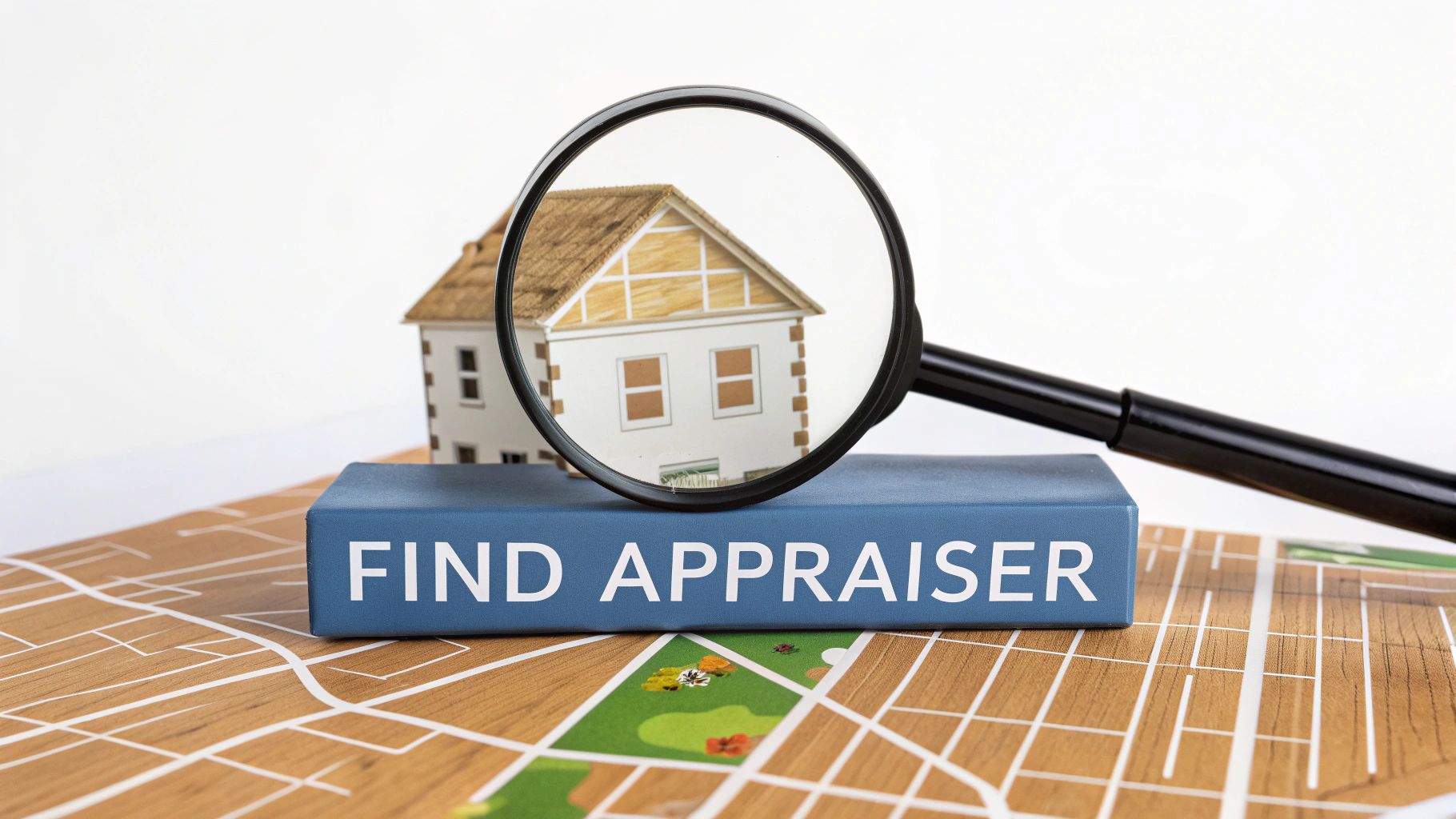
You’ve got a solid shortlist of potential experts. Now comes the critical part: matching the right appraiser to your specific piece. This isn't a one-size-fits-all situation. An expert in 18th-century French furniture probably isn't the best person to look at your mid-century modern pottery collection.
The first thing you need to do, no exceptions, is confirm the appraiser is USPAP-compliant. The Uniform Standards of Professional Appraisal Practice (USPAP) is the gold standard for the profession, ensuring ethical conduct and credible results. Think of it as the foundation of a trustworthy valuation.
Questions to Ask a Potential Appraiser
Before you hire anyone, get them on the phone. This isn't just about logistics; it's your chance to get a feel for their experience and professionalism. Treat it like a mini-interview.
Here are the key questions I always recommend asking:
- "What is your area of specialization?" A vague answer like "general antiques" is a red flag. You want to hear something specific, like, "I specialize in American folk art" or "My primary focus is vintage timepieces."
- "Have you appraised items similar to mine recently?" This gets right to the point. You need someone with current, hands-on experience with objects like yours to understand the latest market trends.
- "How do you structure your fees?" A professional will charge either a flat rate or an hourly fee. Never, ever hire an appraiser who wants a percentage of your item's value. That’s a massive conflict of interest.
An appraiser's fee should be based on their time and expertise, not on the value of your item. This ethical boundary ensures you receive an unbiased and objective valuation, free from any incentive to inflate or deflate the numbers.
Getting these details sorted out upfront will save you a lot of headaches later. For those who want to learn more, our guide on how to value antiques for modern collectors dives deeper into the valuation process.
Ultimately, finding the right person with the precise expertise your antique deserves is how you uncover its true story and value.
Navigating the Modern Antiques Market
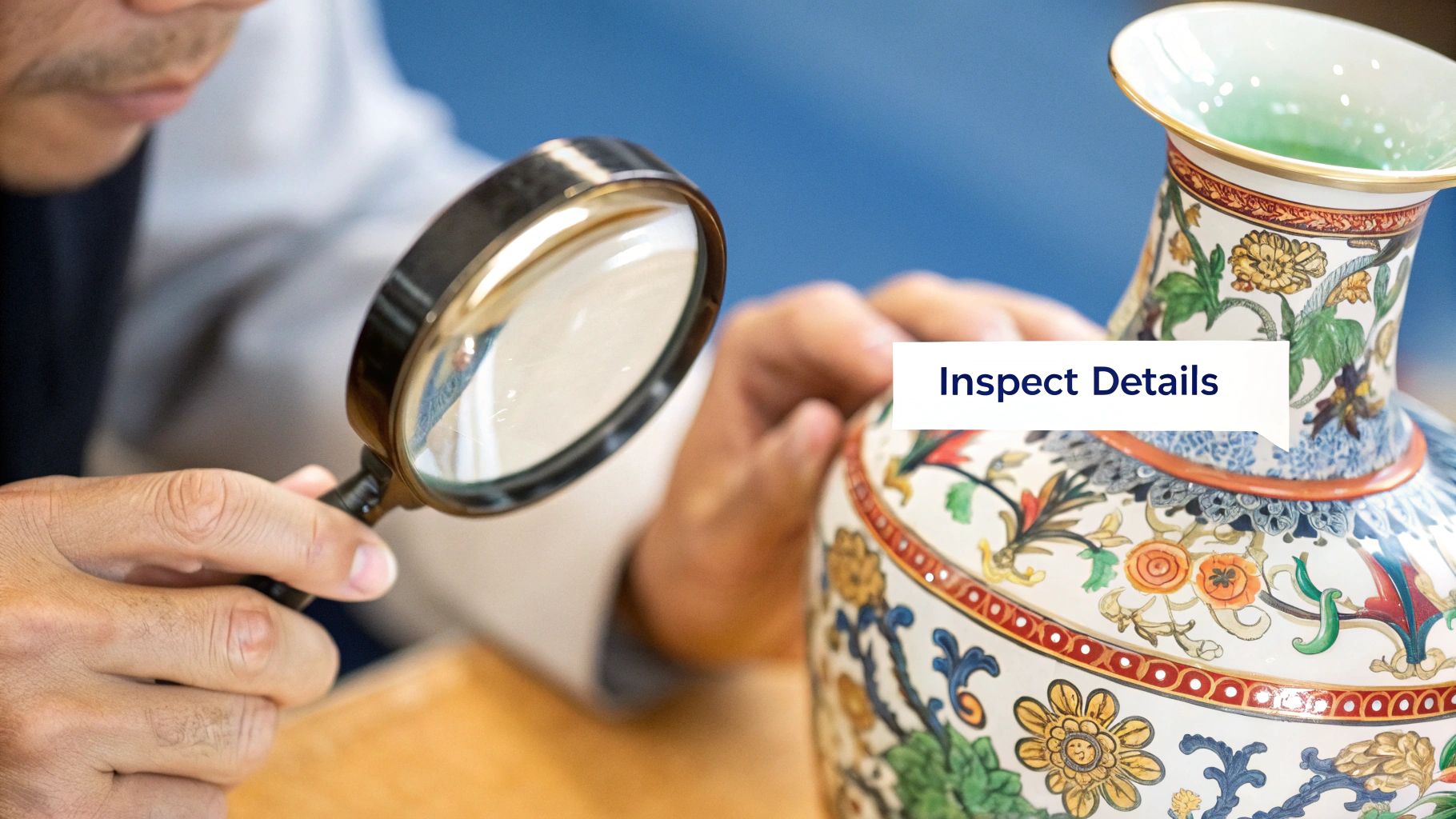
The first thing to understand is that an antique’s value isn't set in stone. It's a moving target, constantly shifting with market trends, pop culture moments, and what collectors are currently chasing.
Think of it this way: what was all the rage a decade ago might gather dust today, while something once overlooked is now flying off the shelves. The sleek lines of Mid-Century Modern furniture and the vibrant colors of vintage Pyrex are perfect examples. A new generation of collectors, often driven by nostalgia, is completely reshaping what’s considered "in."
What Really Drives an Antique's Value?
When an appraiser looks at your piece, they’re seeing more than just its age and condition. They're weighing it against a complex, dynamic market. From my experience, it really boils down to three key things:
- Provenance: This is just a fancy word for the item's life story. Who owned it? A simple wooden chair is one thing; the same chair that belonged to a famous author is another story entirely. A clear history can dramatically increase value.
- Rarity: Plain and simple, how many of these are out there? A mass-produced teapot will nearly always be less valuable than a rare, one-of-a-kind creation from a celebrated artisan.
- Current Demand: This is the big one. Are people actively searching for your item right now? A hot market with eager collectors can send prices soaring, sometimes overnight.
And this market isn't just changing—it's exploding. The global antiques and collectibles market was valued at around $500 million in 2023 and is on track to double by 2033. This boom is fueled by younger buyers and the rise of online marketplaces, which now handle about 20% of all sales. You can get a better sense of what's driving antique investment trends to see where the money is flowing.
An appraisal isn't just about what your item is; it's about what it's worth to an eager buyer today. Keeping these market forces in mind helps you understand the story behind the number on that valuation report.
What to Expect From an In-Person Appraisal
So, you've found a local appraiser and booked an appointment. Walking in can feel a little intimidating, maybe even like you’ve stepped onto the set of Antiques Roadshow. But in reality, it's a straightforward and often fascinating process.
The first thing a good appraiser does is get hands-on with your item. Think of them as a detective, meticulously examining every detail for clues that tell your object’s story.
The Physical Examination
This isn't just a quick look-over. A seasoned appraiser will spend time carefully inspecting your piece, paying close attention to a few key areas:
- Maker's Marks & Signatures: These are the holy grail. A tiny stamp, a faint signature, or a specific guild mark can instantly tell an appraiser who made it, where, and when.
- Materials & Construction: Is that chest made of oak or pine? Are the drawers dovetailed by hand or by a machine? An expert knows the specific materials and construction techniques used in different time periods, which helps them date an item with surprising accuracy.
- Condition & Past Repairs: They’ll look for subtle signs of wear, damage, or restoration. A nearly invisible hairline crack in a vase or a well-done furniture repair can have a big impact on the final value.
A skilled appraiser can often tell you more about your object in the first five minutes of this physical inspection than you’ve learned in years of owning it.
The Research and Valuation
After the hands-on part, the appraiser hits the books—or more likely, their specialized databases. This is where they connect your specific item to the wider market, comparing it to similar pieces that have recently sold.
They'll dig through auction records, dealer price guides, and historical sales data to find what are known as "comparables." It’s all about finding documented proof of what similar items are actually fetching right now. This is a crucial part of navigating the massive global antiques market, which is a surprisingly complex industry. You can get a sense of the scope of the global antiques market and see just how much data they're working with.
An appraisal isn't just a gut feeling or an educated guess. A professional appraiser builds a case for their valuation based on concrete market evidence.
Ultimately, it’s this powerful combination of hands-on expertise and deep, diligent research that results in an accurate and defensible valuation for your treasured piece.
Decoding Your Final Appraisal Report
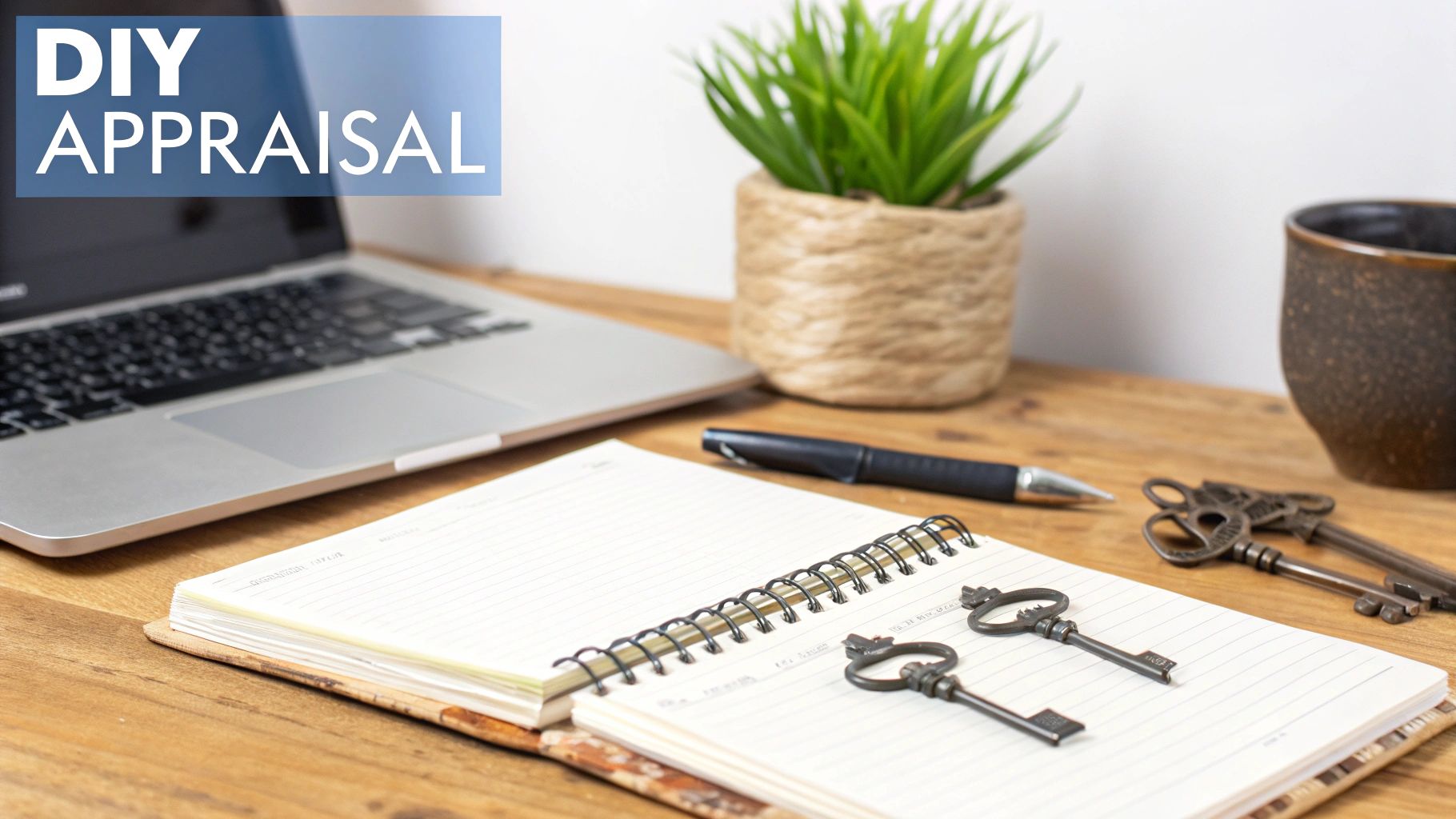
Once the appraiser has finished their physical examination and market research, you'll get a formal appraisal report. This isn't just a single number on a piece of paper. A proper report is a detailed breakdown that walks you through exactly how they landed on their valuation.
A professional report will always have a few key sections. You should see a thorough description of the item—its materials, dimensions, and any maker's marks or signatures. It will also include a condition report, which is an objective look at any wear, damage, or repairs that affect the item's worth.
Finally, and most importantly, the report will state the valuation methodology and the final value. But here's something many people don't realize: not all values are created equal. This is where you need to understand the different types of valuation.
The Three Types of Value Explained
The number on your report is pretty meaningless without its context. A good appraiser will always specify which type of value they've assigned, because each one serves a very different purpose.
Fair Market Value (FMV): Think of this as the "real world" selling price. It's what a willing buyer would likely pay a willing seller when neither is in a rush. This is the most common valuation you'll see, used for everything from estate settlements to figuring out a good asking price. For a much more detailed breakdown, check out our guide on what fair market value means for your antiques.
Replacement Value: This figure is almost always higher than FMV. It represents the full retail cost to go out and replace your exact item with a new or comparable one. This is the number your insurance company cares about.
Liquidation Value: This is the lowest of the three. It’s the fire-sale price—what you could expect to get if you had to sell the item immediately, without time to find the right buyer.
Understanding these distinctions is critical. If you try to sell your item using its Replacement Value, you'll likely be very disappointed. On the flip side, using a Liquidation Value for insurance could leave you seriously under-covered in case of a loss.
The context for these values comes from the market itself. For example, the global art and antiques market saw its transaction volume grow by 3% in 2024. Even more telling is that the market is buzzing for items under $50,000, which shows there's a lot of healthy activity at more accessible price points. This is the kind of data an appraiser uses to pinpoint Fair Market Value. If you're curious, you can dig into more of these trends in the global art market report for 2024.
A Few Common Questions About Antique Appraisals
When you start searching for an "antique appraisal near me," a few questions almost always pop up. Getting these sorted out ahead of time can make the whole experience feel less intimidating and a lot more straightforward.
First up, what's this going to cost me? Most professional appraisers will charge an hourly rate. You can expect this to fall somewhere between $150 and $400, depending on their specialty and where you're located. A huge red flag, though, is an appraiser who wants to charge a percentage of your item’s value. That’s a major conflict of interest and not something a reputable expert would ever do.
Should I Clean My Item Before the Appraisal?
I get this question all the time, and the answer is almost always a firm no. It’s completely natural to want your piece to look its best, but you could accidentally cause serious harm. Trying to "fix" it up can strip away the patina—the aged finish that collectors love—or cause damage that can't be undone, tanking its value in an instant. It's always best to let the appraiser see it exactly as you found it.
A quick tip: Don't forget to bring along any paperwork you have. This could be old receipts, letters from family members, or even stories you remember about where the item came from. This history is called provenance, and it can add crucial context that sometimes makes a huge difference in the final valuation.
Ready to get a head start on discovering your item's story right from your couch? The Curio app gives you instant identification and a preliminary valuation from your phone. You can get started at https://www.curio.app.
